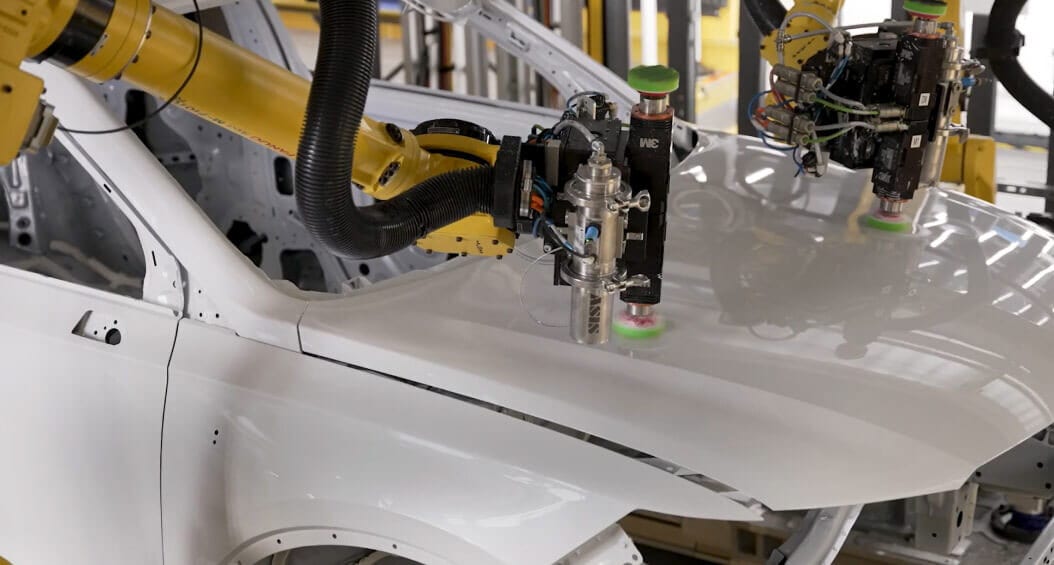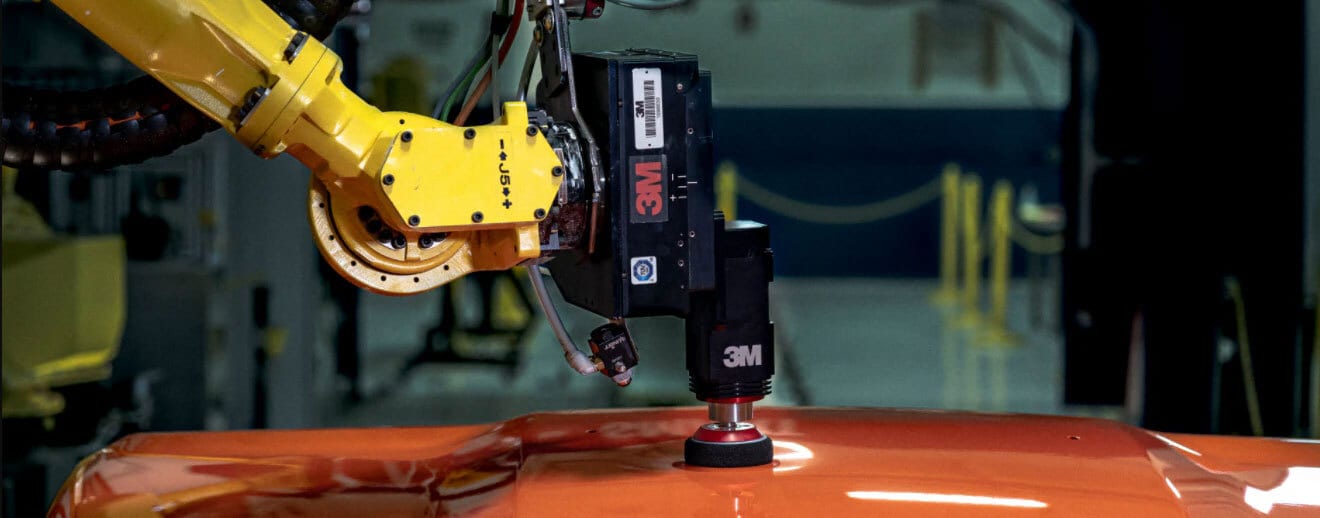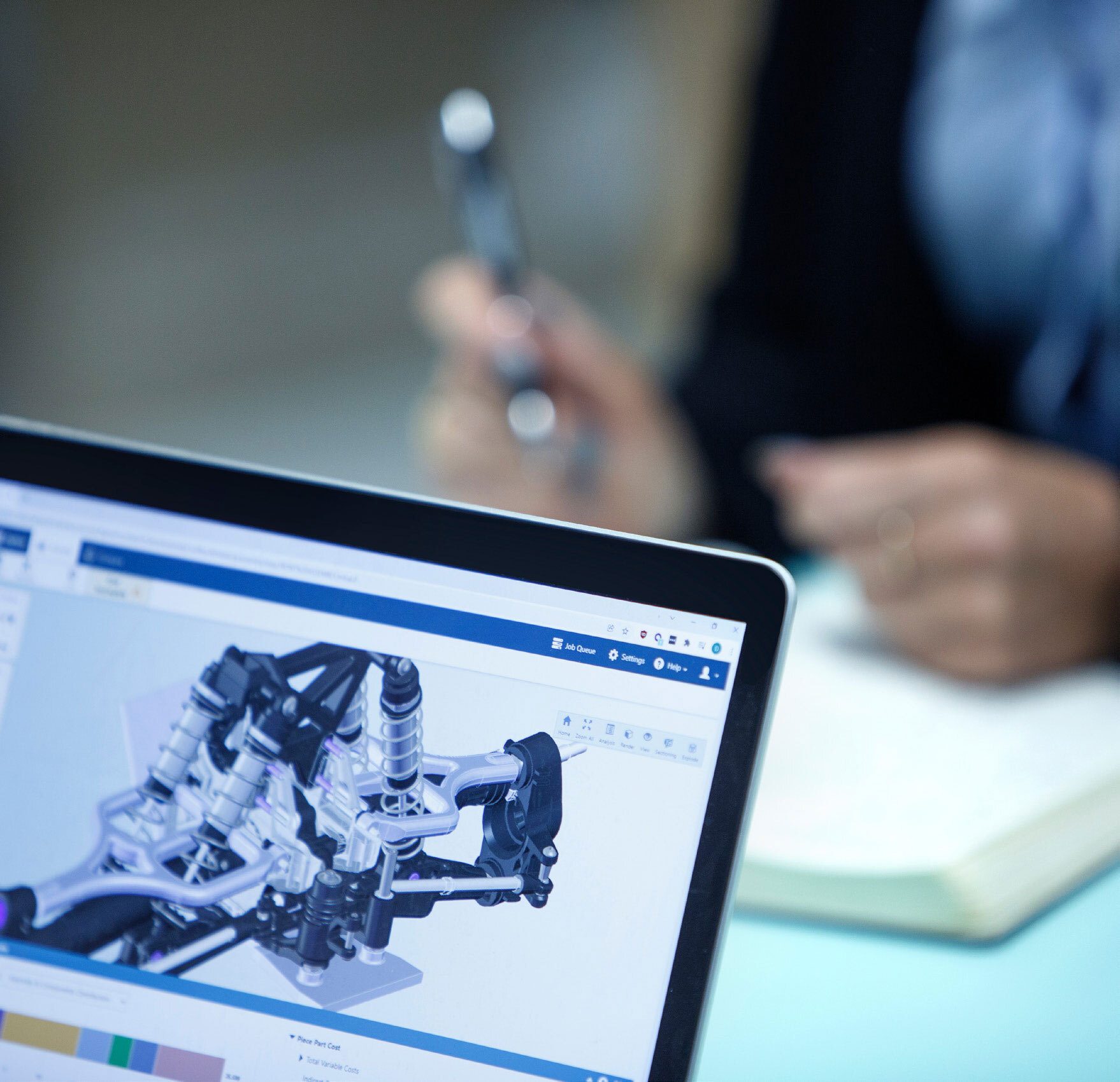ROBOTICS REVIEW
CONTACT
Austin

Lightweight battery-powered aircraft are ready for take-off.
Austin Weber // Senior Editor // webera@bnpmedia.com
General Motors and 3M Partner on New Robotic Paint System
A new robotic paint inspection system improves quality and efficiency. Photo courtesy 3M
ROBOTICS PRODUCTS
Fit and finish are two of the most important things that new car buyers usually look for. Whether it’s a sports car, a luxury sedan, a sport utility vehicle or a pickup truck, paint quality is more critical than ever.
Unfortunately, many vehicles exiting paint shops have defects that require manual inspection and repair to ensure the level of quality customers expect. Most automakers rely on dozens of highly skilled operators for this task.
That makes topcoat defect repair one of the most highly manual operations in the automotive industry. Traditionally, it has been labor-intensive, unpredictable and difficult to automate.
However, engineers at General Motors recently partnered with 3M on something that has never been done before in automotive manufacturing: automated paint repair on a moving production line. The first application was installed at GM’s Spring Hill, TN, plant, which mass-produces Cadillac SUVs such as the XT5 and XT6.
3M’s Finesse-it robotic paint repair system makes the inspection and rework process more efficient and accurate. It uses six-axis robots from FANUC America Corp., in addition to stream motion software, process modeling and abrasive technology, to fix imperfections in the topcoat.
The AGV provides 50-course 128-command control, programming. The AGV is a model HA-A50060 single-direction AGV drive unit with 90° and 180° spin/turn capability. The unit can travel with speeds up to 164 fpm (50 M)/min and can carry a load capacity of up to 1320 lb.
Creform Corporation
800.839.8823
SCsales@creform.com
www.creform.com
AGV system with powered conveyor help increase productivity.
A state-of-the-art vision system checks each vehicle from all angles to find and categorize any problems. Next, vehicles move to sanding and polishing. Lightweight M-710iC/70 robots that feature slim wrists, rigid arms and small footprints are equipped with end effectors that hold abrasive discs. They follow precise instructions to fix any imperfections using 3M abrasives and polishes.
The automated system uses advanced software supplied by Inovision Inc. to efficiently sand and polish automotive finishes using its AI-driven SMARTInspect paint inspection system that ensures precision and reliability.
Most automated inspection systems require each vehicle to stop and then be scanned. However, SMARTInspect scans, identifies and classifies defects as vehicles move through a scanning ring at normal line speed.
Inovision’s technology uses the measurement principle of deflectometry, which is based on the reflection of regular geometrical pattern on an object’s surface. When light passes off a reflective surface, any imperfections on the surface are detected.
The SMARTInspect system can detect any imperfection that causes a perturbation in the light reflection as a vehicle passes by. Imperfections over 0.2 millimeter can cause light perturbations in the system.

This automated system uses AI-driven software and an advanced vision system to efficiently sand and polish automotive finishes. Photo courtesy FANUC America Corp.
“We are streaming information to that robot approximately every 10 milliseconds,” says Marcus Pelletier, global R&D director of systems development at 3M. “Because we’re doing it in real-time, if we detect something when the tool touches the car, we can modify our trajectories dynamically on the fly so that we end in the right spot every time.”
“This is the final frontier of automation in a high-volume paint shop,” adds Ryan Odegaard, director of paint polymers and additive manufacturing at General Motors. “Many of our processes are already automated and this is a very complicated area to think about automating.
“If you have a customer-facing product, you have to make sure that that paint finish is perfect, because it’s the first thing you see when you go into a dealership,” explains Odegaard.
But, Odegaard says finding and fixing surface imperfections has typically been one of the most labor-intensive steps for car manufacturers. “Basically, you have layers of inspection and layers of people who are interfacing with that surface to correct those surface issues,” he points out.

Automating paint defect repair can help automakers improve consistency and reduce costs. Photo courtesy 3M
According to Pelletier, automating paint defect repair can help automakers improve consistency and reduce costs. With Finesse-it, each task is performed to the exact same degree of effectiveness every time.
“Despite the many variables introduced across different color lines of vehicles and across shifts of individual operators, the same quality of repair will be executed day after day with consistency,” claims Pelletier. “Automation can [also] help reduce cycle times and increase part quality. That, in turn, can protect and enhance brand perception, while helping to reduce dealer rework and warranty claims.”
ASSEMBLY ONLINE
For more information on robotic applications in automotive manufacturing, visit www.assemblymag.com to read these articles:





